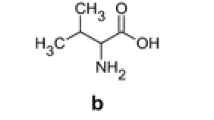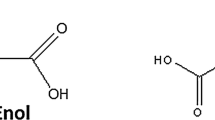Abstract
A series of chiral amino acids in the levo form used in the current terrestrial biochemistry were irradiated in the solid and dry state with γ-radiation to a dose of 3.2 MGy which is the dose equivalent to that derived by radionuclide decay in comets and asteroids in 1.05 × 109 years at a depth >20 m. For each amino acids, the radiolysis degree and the radioracemization degree was measured, respectively by differential scanning calorimetry (DSC) and by optical rotatory dispersion (ORD) spectroscopy. From these measurements, a radiolysis rate constant k dsc and a radioracemization rate constant k rac were determined for each amino acid and extrapolated to a dose of 14 MGy which corresponds to the expected total dose delivered by the natural radionuclides decay to all the organic molecules present in comets and asteroids in 4.6 × 109 years, the age of the Solar System. It is shown that all the amino acids studied survive a radiation dose of 3.2 MGy although part of them is lost in radiolytic processes. Similarly also the radioracemization process accompanying the radiolysis does not extinguish the initial enantiomeric enrichment. Even the extrapolation to 14 MGy corresponding to 4.6 × 109 years shows the partial survival of all amino acids studied and their enantiomeric enrichment. The knowledge of the radiolysis and radioracemization rate constants may permit the calculation of the original concentration of the amino acids at the times of the formation of the Solar System starting from the concentration found today in carbonaceous chondrites. Based on these results, it is not at all a surprise that amino acids have been found in meteorites and in measureable chiral excess. Furthermore, the amino acids showing the best level of radiolysis and radioracemization resistance are just those commonly found in enantiomeric enrichment in meteorites.




Similar content being viewed by others
References
Bonner WA, Blair NE, Lemmon RM (1979) The radioracemization of amino acids by ionizing radiation: geochemical and cosmochemical implications. Origins Life Evol Biosph 9:279–290
Cataldo F (2007a) Gamma radiolysis of chiral terpenes: α(+)pinene and α(-)pinene. J Radioanal Nucl Chem 272:82–90
Cataldo F (2007b) Radiation-induced racemization and amplification of chirality: implications for comets and meteorites. Int J Astrobiol 6:1–10
Cataldo F, Strazzulla G, Iglesias-Groth S (2009) Stability of C60 and C70 fullerene toward corpuscular and gamma radiation. Mon Not R Astronom Soc 394:615–623
Cataldo F, Angelini G, Iglesias-Groth S, Manchado A (2010a) Solid state radiolysis of amino acids in an astrochemical perspective. Radiat Phys Chem 80:57–65
Cataldo F, Ragni P, Iglesias-Groth S, Manchado A (2010b) Solid state radiolysis of sulphur-containing amino acids: cysteine, cystine and methionine. J Radioanal Nucl Chem 287:573–580
Cataldo F, Ragni P, Iglesias-Groth S, Manchado A (2010c) A detailed analysis of the properties of radiolyzed proteinaceous amino acids. J Radioanal Nucl Chem (accepted for publication)
Coen BA, Chyba CF (2000) Racemization of meteoric amino acids. Icarus 145:272–281
Cronin JR, Pizzarello S (2000) Chirality of meteoritic organic matter: a brief review. In: Goodfriend GA, Collins MJ, Fogel ML, Macko SA, Wehmiller JF (eds) Perspective in amino acid and protein geochemistry, Chap 2. Oxford University Press, Oxford
Czechovski L, Leliwa-Kopystynski J (2003) Tidal heating and convection in the medium sized icy satellites. Celest Mech Dyn Astron 87:157–189
Djerassi C (1960) Optical rotatory dispersion applications to organic chemistry, Chap 15. McGraw-Hill, New York
Draganic IG, Draganic ZD, Adloff JP (1993) Radiation and radioactivity on the earth and beyond. CRC Press, Boca Raton
Iglesias-Groth S, Cataldo F, Ursini O, Manchado A (2011) Amino acids in comets and meteorites: stability under gamma radiation and preservation of the enantiomeric excess. Mon Not Roy Astronom Soc 410:1447–1453
Izumi Y, Matsui T, Koketsu T, Nakagawa K (2008) Preservation of homochirality of aspartic acid films irradiated with 8.5 eV vacuum ultraviolet light. Radiat Phys Chem 77:1160–1163
Jirgensons B (1973) Optical activity of proteins and other macromolecules, Chap IV. Springer, Berlin
Jorissen A, Cerf C (2002) Asymmetric photoreactions as the origin of the biomolecular homochirality: a critical review. Orig Life Evol Biosph 32:129–142
Kminek G, Bada JL (2006) The effect of ionizing radiation on the preservation of amino acids on Mars. Earth Planet Sci Lett 245:1–5
Kohman TP (1997) Aluminium-26 a radionuclide for all seasons. J Radioanal Nucl Chem 219:165–176
Kvenvolden KA, Glavin DP, Bada JL (2000) Chirality of meteoritic organic matter: a brief review. In: Goodfriend GA, Collins MJ, Fogel ML, Macko SA, Wehmiller JF (eds) Extraterrestrial amino acids in the Murchinson meteorite: re-evaluation after thirty years, Chap 1. Oxford University Press, Oxford
Kwok S (2009) Organic matter in space: from star dust to the Solar System. Astrophys Space Sci 319:5–21
Meierhenrich UJ (2008) Amino acids and the asymmetry of life. Springer, Berlin
Meierhenrich UJ, Nahon L, Alcaraz C, Bredehoft JH, Hoffmann SV, Barbier B, Brack A (2005) Asymmetric photolysis of the amino acid leucine in the solid state. Angew Chem Int Ed 44:2–5
Merk R, Prialnik D (2003) Early thermal and structural evolution of small bodies in the trans-neptunian zone. Earth Moon Planets 92:374–395
Miller SL (1953) A production of amino acids under possible primitive earth conditions. Science 117:528–529
Miller SL (1955) Production of some organic compounds under primitive earth conditions. J Am Chem Soc 77:2351–2361
Miller SL (2000) The endogenous synthesis of organic compounds. In: Brack A (ed) The molecular origin of life: assembling the pieces of a puzzle, Chap 3. Cambridge University Press, Cambridge
Miller SL, Orò J (1981) Harold C. Urey 1893–1981. J Mol Evol 17:263–264
Pizzarello S, Cronin JR (2000) Non-racemic amino acids in the Murray and Murchison meteorites. Geochim Cosmochim Acta 64:329–338
Pizzarello S, Huang Y, Alexandre MR (2008) Molecular asymmetry in extraterrestrial chemistry: insights from a pristine meteorite. Proc Natl Acad Sci 105:3700–3704
Prialnik D (2002) Modeling the comet nucleus interior. Earth Moon Planets 89:27–52
Prialnik D, Bar-Nun A (1990) Heating and melting of small icy satellites by the decay of Al26. Astrophys J 355:281–286
Prialnik D, Bar-Nun A, Podolak M (1987) Radiogenic heating of comets by Al26 and implications for their time of formation. Astrophys J 319:993–1002
Prialnik D, Sarid G, Rosenberg ED, Merk R (2008) Thermal and chemical evolution of comet nuclei and Kuiper belt objects. Space Sci Rev 138:147–164
Sagan C, Khare BN (1971) Long wavelength ultraviolet photoproduction of amino acids on the primitive earth. Science 173:417–420
Sagstuen E, Sanderud A, Hole EO (2004) The solid-state radiation chemistry of simple amino acids (revisited). Radiat Res 162:112–119
Sephton MA (2002) Organic compounds in carbonaceous meteorites. Nat Prod Rep 19:292–311
Taguchi M, Hayano K, Xu Y, Moriyama M, Kobayashi Y, Hiratsuka H, Ohno SI (2001) Yields of tyrosines in the radiolysis of aqueous phenylalanine solutions by energetic heavy ions. Radiat Phys Chem 60:263–268
Unsold A, Baschek B (2002) The new cosmos: an introduction to astronomy and astrophysics. Springer, Berlin
Urey HC (1952) On the early chemical history of the earth and the origin of life. Proc Natl Acad Sci USA 38:351–363
Urey HC (1955) The cosmic abundances of potassium, uranium and thorium and the heat balance of the earth the moon and mars. Proc Natl Acad Sci USA 41:127–144
Urey HC (1956) The cosmic abundances of potassium, uranium and thorium and the heat balance of the earth, the moon and mars. Proc Natl Acad Sci USA 42:889–891
Yabushita S (1993) Thermal evolution of cometary nuclei by radioactive heating and possible formation of organic chemicals. Mon Not R Astronom Soc 260:819–825
Author information
Authors and Affiliations
Corresponding author
Rights and permissions
About this article
Cite this article
Cataldo, F., Ursini, O., Angelini, G. et al. Radiolysis and radioracemization of 20 amino acids from the beginning of the Solar System. Rend. Fis. Acc. Lincei 22, 81–94 (2011). https://doi.org/10.1007/s12210-011-0116-6
Received:
Accepted:
Published:
Issue Date:
DOI: https://doi.org/10.1007/s12210-011-0116-6




